Jambalaya is one of those dishes that feels like home to me. With my Louisiana roots, I grew up knowing everybody has their own version, some use sausage and chicken, others load it with seafood, and in my family, seafood always belongs in jambalaya. After sharing Southern recipes online for over a decade, I can promise this one turns out the way it should, well seasoned and guaranteed to bring people to the table.

Want to save this recipe for later?
You will also love my Southern fried chicken, seafood gumbo, Jambalaya Soup, and Southern cheese grits recipes.

Seafood Jambalaya Ingredients
Jambalaya starts with the Holy Trinity vegetables: celery, green bell peppers, and onions. These are considered the foundation of many dishes and are used to create a flavorful base for gumbo, jambalaya, dirty rice, grits, and more.
You can use whatever type of seafood you like. Just be sure to cook it separately from the rice. Seafood cooks fast. You don't want to cook it for longer than a few minutes or it will become rubbery and tough. I add shrimp and lump crab meat. You can also use lobster, crawfish, oysters or fish.
Here are other things you will need:
- Smoked Sausage: Andouille sausage is the favorite. It's a smoked pork sausage that originates from Louisiana and has a robust, spicy flavor which complements the other ingredients in jambalaya. You can use any smoked or standard sausage.
- Shrimp
- Crab
- Broth
- Garlic
- Rice: Traditionally, long-grain white rice is used. This type of rice helps prevent the dish from becoming overly mushy. Other types of rice like short-grain white rice or brown rice can also be used, but they will require different cooking times and adjustments to the liquid ratio in the recipe.
- Flour
- Creole Seasoning and Bay Leaves (optional): Creole Seasoning is known for it's bold aromatic flavor and includes spices like thyme, oregano, garlic powder, onion powder, black pepper, and celery seed. It isn't spicy, in comparison to Cajun seasoning.
- Tomatoes: This one is always a debate! The use of tomatoes really just depends on if you want a Creole or Cajun dish. Creole dishes are usually made with tomatoes. If you don't want to add tomatoes, then don't. It will not alter the preparation or cooking time of the dish.
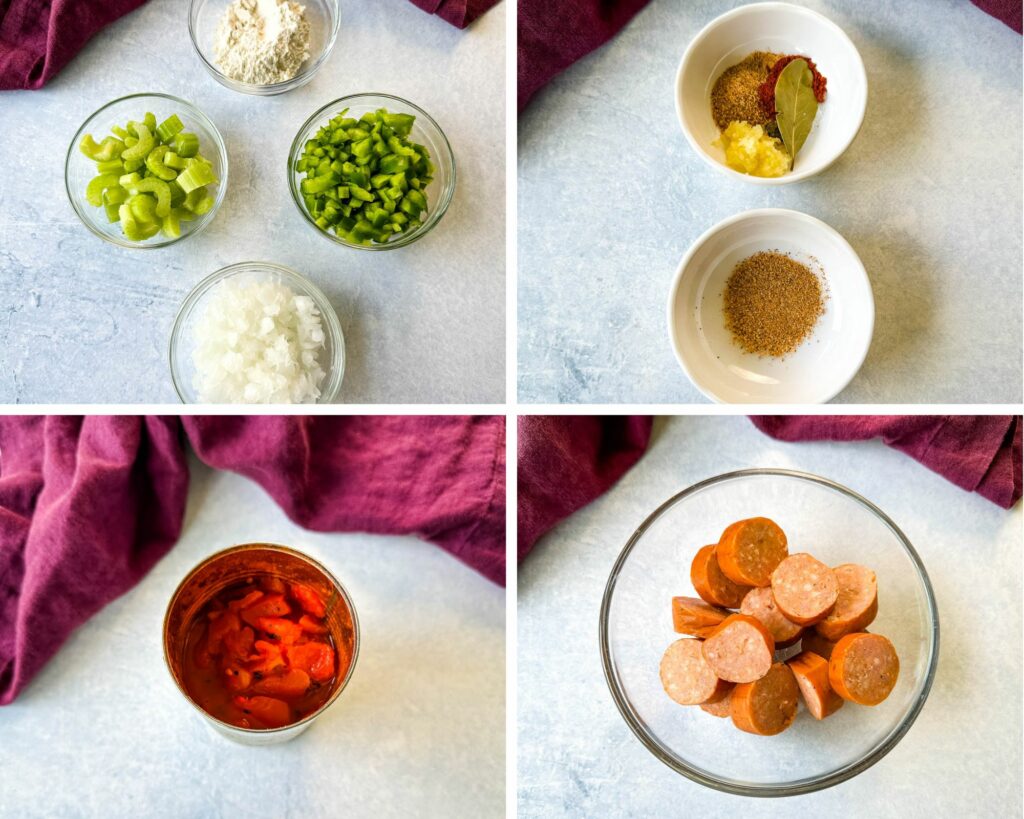
What is Jambalaya
It’s one of those classic Louisiana dishes that’s all about flavor. Think rice cooked in one pot with sausage, chicken, seafood, veggies, and plenty of seasoning. Every family has their own way of making it. In mine, seafood goes in jambalaya, and beef or chicken gets saved for dirty rice. Ask somebody else and you’ll probably hear a whole different rule, that’s just how it goes with Southern food.
There are two main variations of jambalaya. Creole jambalaya is associated with the city of New Orleans and tends to include tomatoes, which give the dish a reddish color.
Cajun jambalaya typically comes from rural areas of Louisiana and usually does not contain tomatoes.
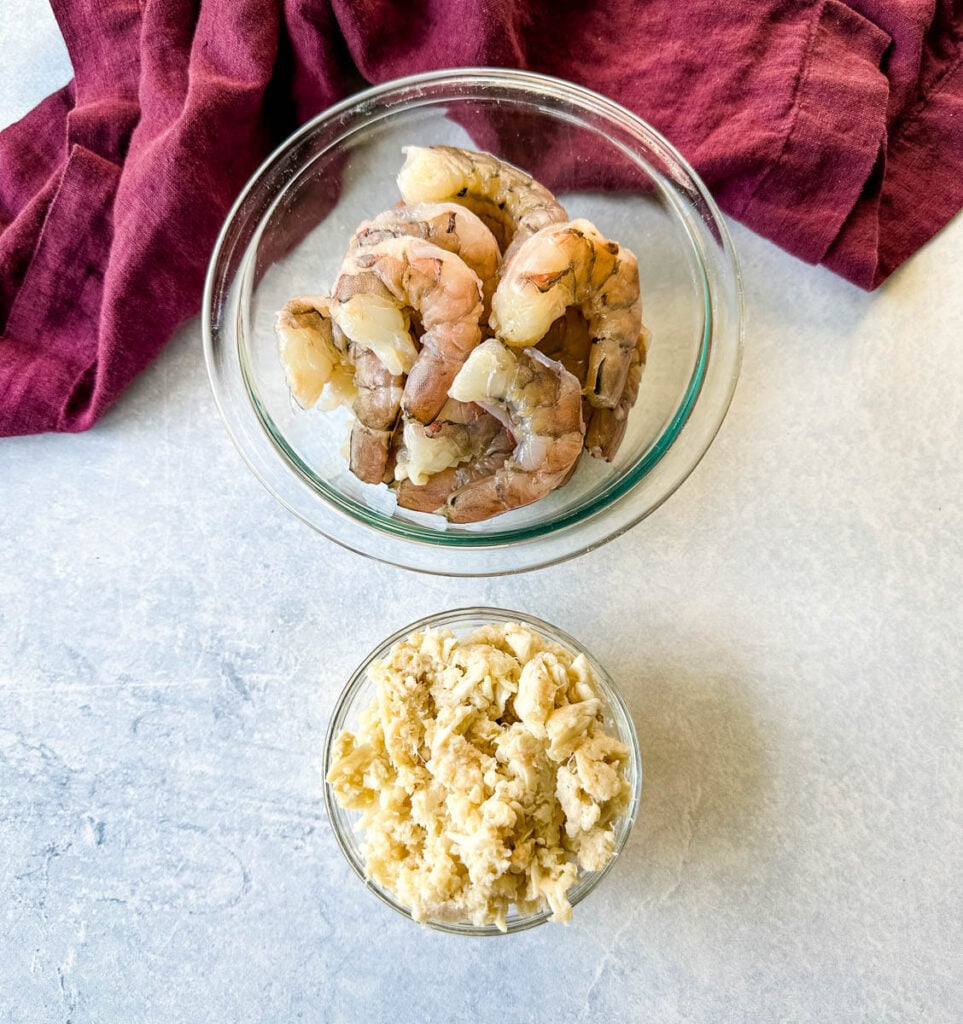
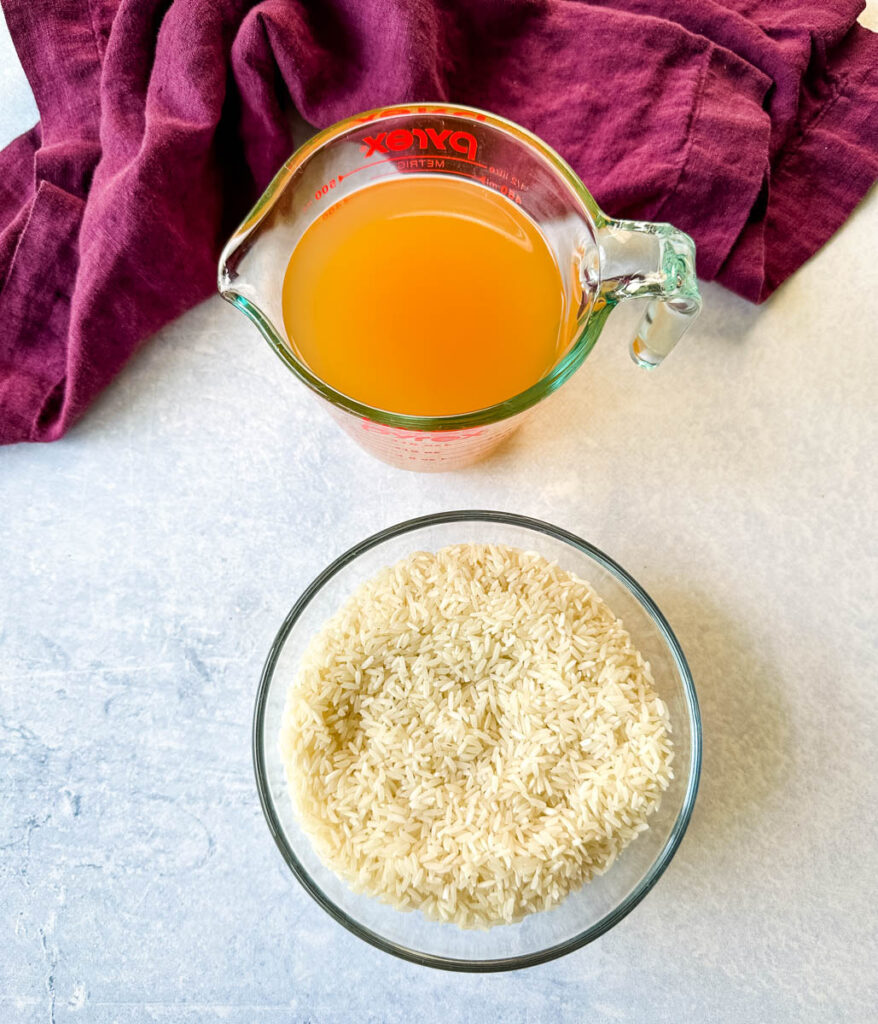
How to Make Seafood Jambalaya with Shrimp
Detailed measurements and full instructions can be found in the recipe card at the bottom of this post.
- Season the shrimp.
- Add olive oil to a pan on medium heat with the seasoned shrimp and cook.
- Remove the shrimp from the pan and set aside. Add the sausage to the pan.
- Cook the sausage. Remove the cooked sausage and set it aside.
- Add in garlic, green peppers, onions and celery. Stir and cook until the onions and garlic are fragrant.
- Add in flour and diced tomatoes. Stir until the mixture is fully coated with flour.
- Add in rice and stir to toast the rice with the flavors of the pan.
- Pour in the broth and add the broth and cooked sausage to the pan.
- Adjust the heat to boiling and add a bay leaf, Creole Seasoning, salt and pepper to taste, and smoked paprika.
- Once the pot reaches a boil, reduce the heat on the stove to low. Cover the pan and simmer.
- Add the shrimp and crab to the rice.
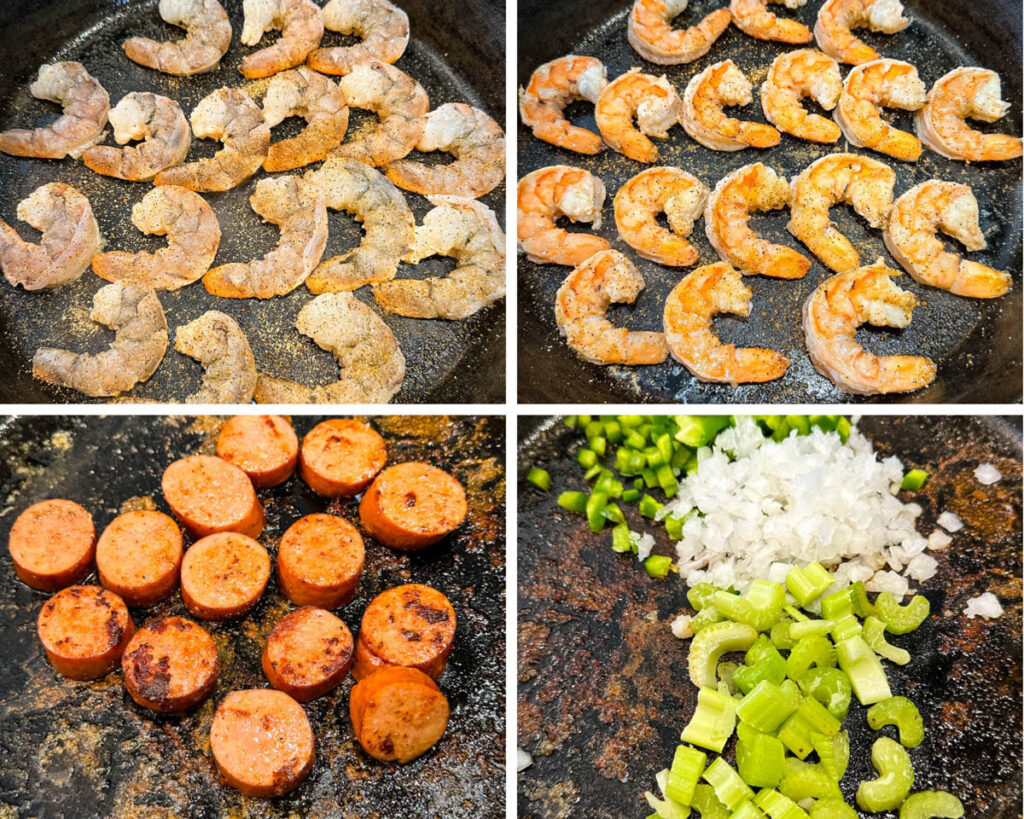
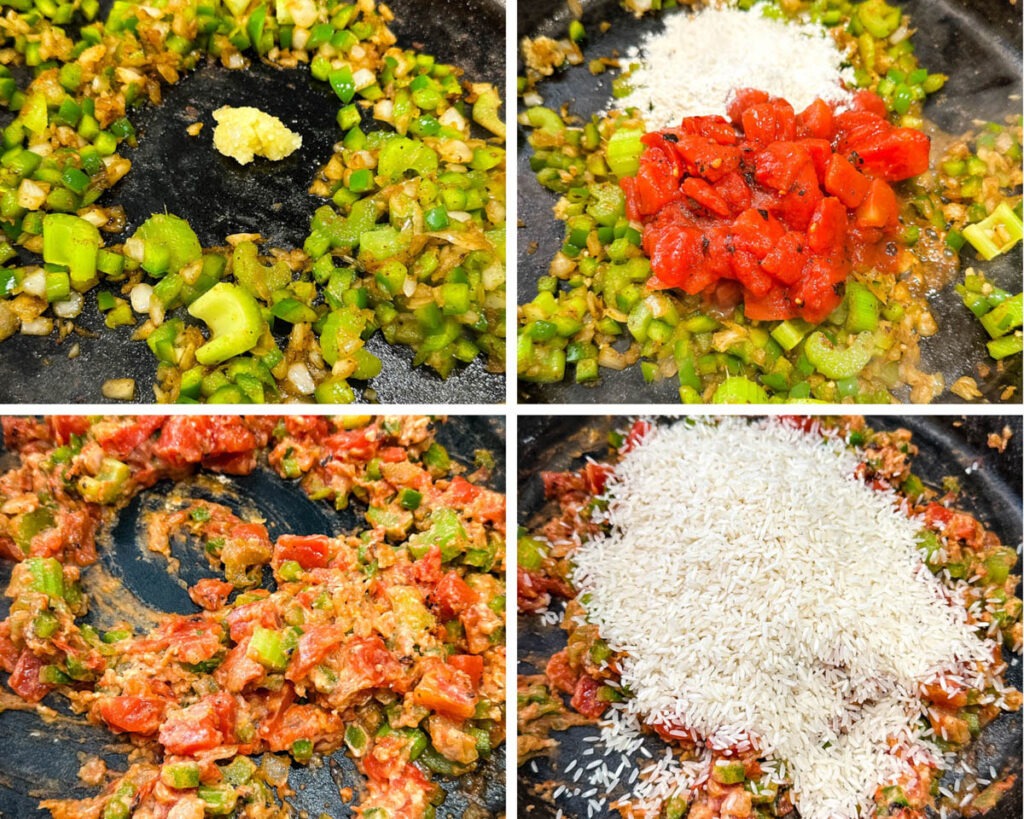
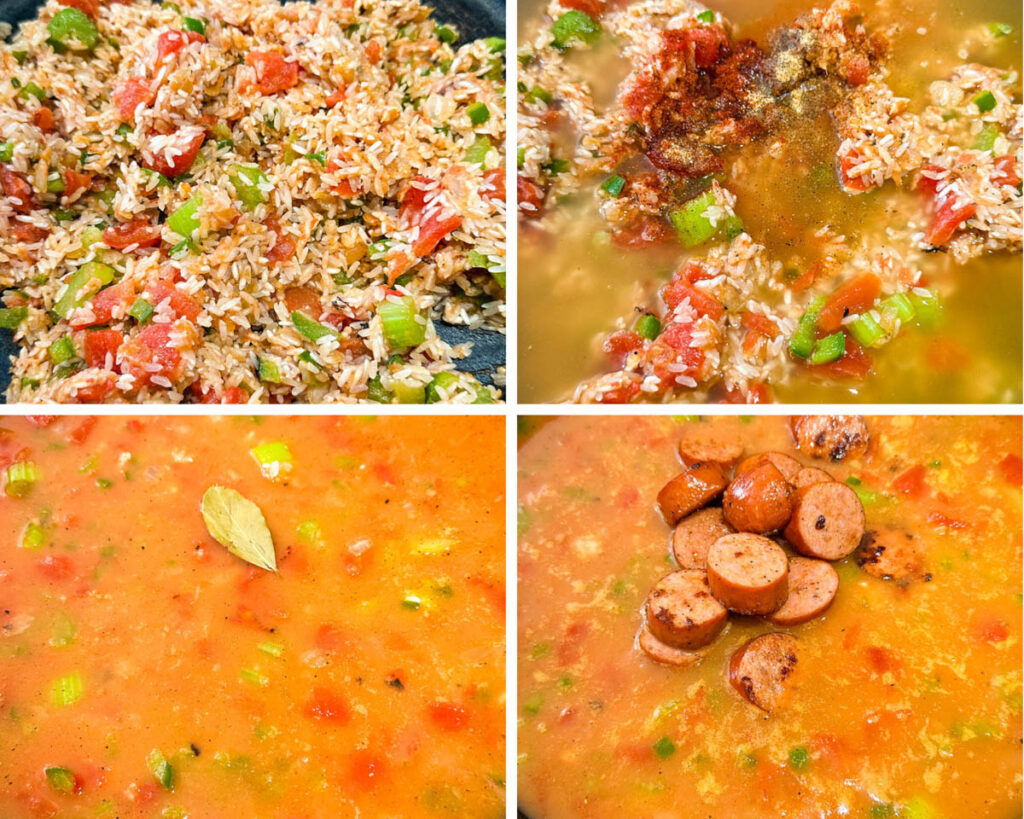
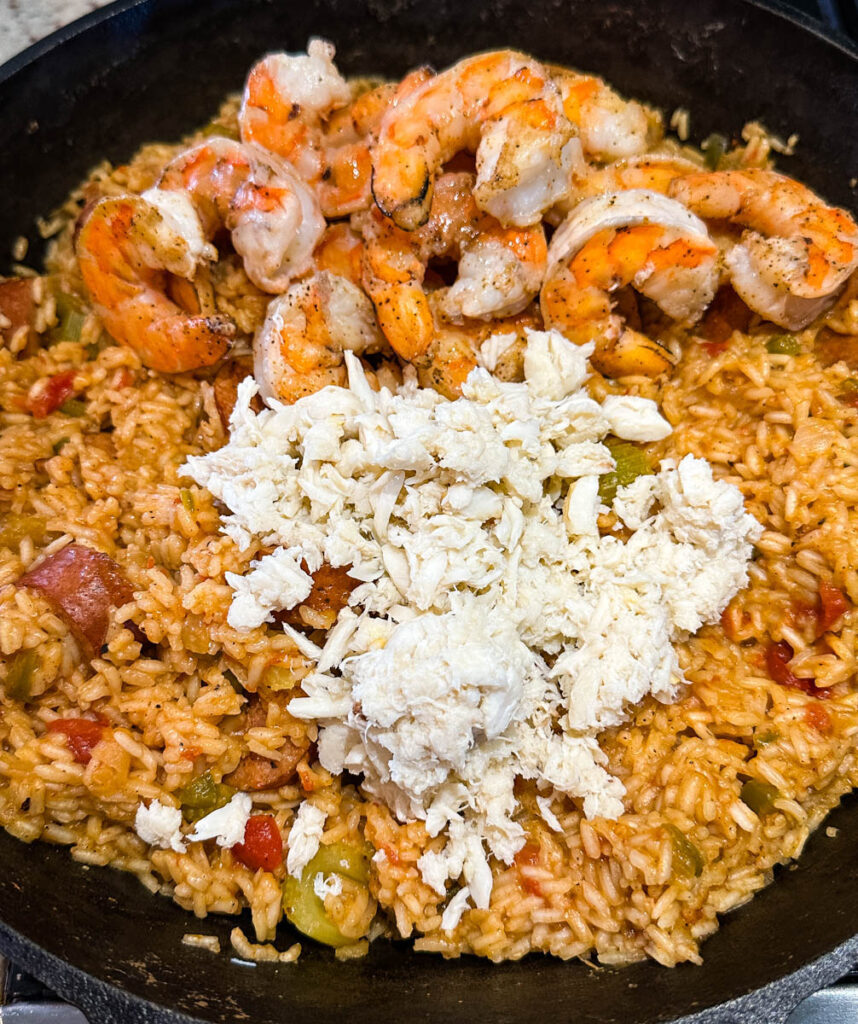
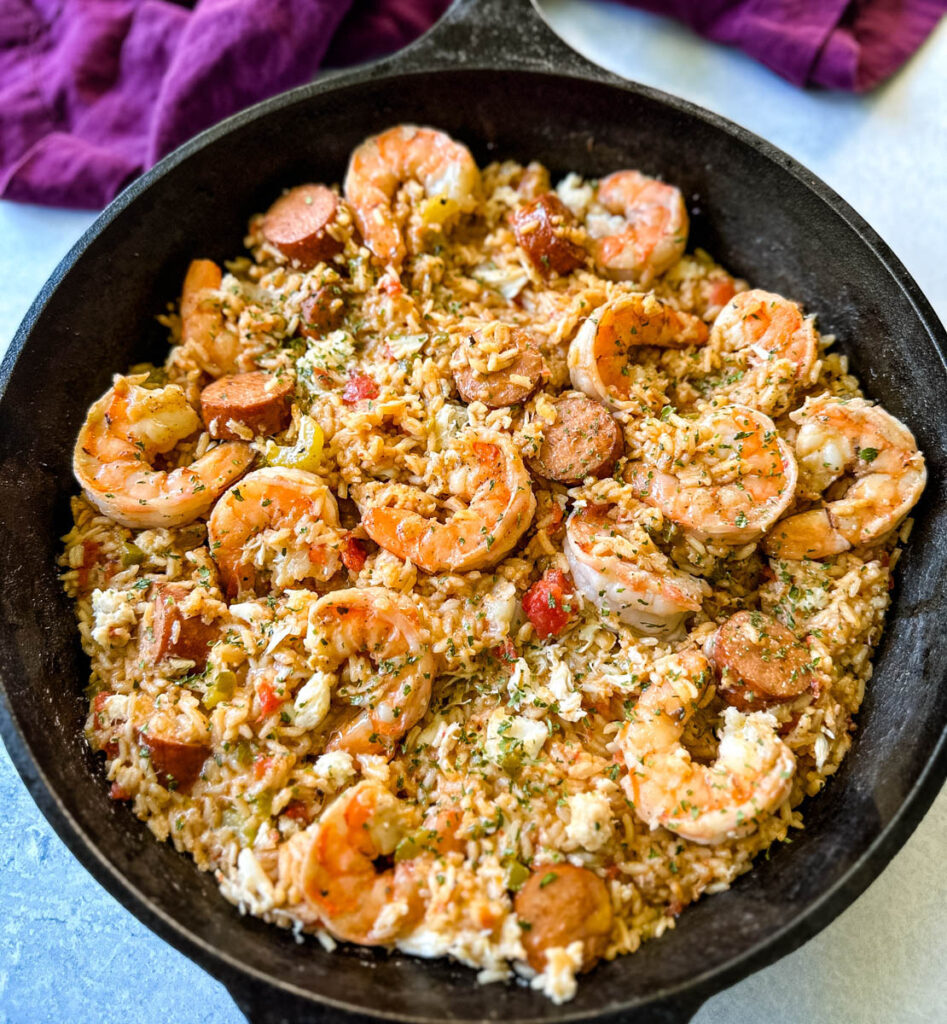
How to Avoid Mushy Jambalaya
No one wants a pan full of mushy rice. That's what can jambalaya a bad name! But, I've got you! Follow my tips:
- Pick the right rice: Go with long-grain rice. It holds its shape, so it soaks up flavor without turning into mush.
- Rinse it off: Give the rice a good rinse before cooking. This washes away extra starch so it doesn’t clump together.
- Toast it first: I like to sauté the rice in a little oil and seasoning before adding the liquid. It coats the grains, adds flavor, and keeps them from soaking up too much moisture too fast.
- Take it easy on the heat: Don’t blast the pot on high, let it simmer gently. Cooking it too fast is the quickest way to end up with mushy rice.
- Don’t stir it to death: Fold the rice in instead of stirring like crazy. Over-stirring releases starch and makes everything sticky. Folding just means using your spoon to scoop from the bottom and gently turn the rice over into the mix.
- Lid on (mostly): Keep the lid on while it cooks so the steam can do its job. Toward the end, crack it just a bit to let extra steam escape if it looks too wet.
- Watch the liquid: If it feels like you’ve got too much liquid hanging out, just uncover the pot and let it cook a few more minutes. The extra moisture will simmer off.
I find the easiest and most foolproof method is to cook the rice separately from the broth mixture. This is a one-pot recipe, so the instructions walk you through how to cook the rice with the broth. But if you're having trouble mastering the perfect texture, try cooking your rice in accordance with the instructions on the packaging of the rice you purchase.
Instead of adding the uncooked rice to the broth, you will add cooked rice at the end once the broth has simmered and when you add the seafood. Instead of using 4 cups of broth in the recipe, you will only need to use 2 cups since you are adding cooked rice that doesn't need to be absorbed by the liquid.
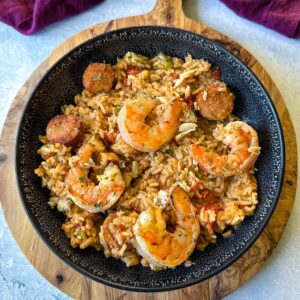
Seafood Jambalaya Recipe
Want to save this recipe for later?
Equipment
Ingredients
- 1 pound raw shrimp Peeled and deveined
- 1 ½ teaspoons Creole Seasoning Divided in ½ teaspoon and 1 teaspoon portions; Adjust to suit your taste.
- 1 teaspoon olive oil
- 6 oz andouille sausage Sliced into small pieces. You can substitute ground sausage pork, turkey sausage, etc.
- ½ cup chopped green peppers
- ½ cup chopped white onions
- ½ cup chopped celery
- 2-3 garlic cloves Minced
- 15.5 oz canned diced tomatoes You can also use fresh tomatoes. I use fire roasted.
- ¼ cup all-purpose flour
- 2 cups long grain white rice Rinsed.
- 4 cups broth or stock Seafood, chicken, vegetable, etc.
- 1 bay leaf
- ½ teaspoon smoked paprika
- salt and pepper to taste
- 8 oz lump crab meat Optional
Instructions
- Season the shrimp with ½ teaspoon of Creole seasoning and salt and pepper to taste.
- Add the olive oil to a pan on medium heat. I used a 12 inch cast iron skillet. Add the seasoned shrimp and cook for 3-5 minutes or until it is pink and opaque.
- Remove the shrimp from the pan and set aside. Add the sausage to the pan.
- Cook the sausage for 4-5 minutes or until it has browned. Remove the cooked sausage and set it aside.
- Add in the garlic, green peppers, onions and celery. Stir and cook until the onions and garlic are fragrant.
- Add in the flour and diced tomatoes. Stir until the mixture is fully coated with flour.
- Add in the rice and stir to toast the rice with the flavors of the pan.
- Pour in the broth and add the broth and cooked sausage to the pan. Use a wooden or silicone spoon and deglaze the bottom of the pan to scoop up any brown bits on the pan. These bits are loaded with flavor.
- Adjust the heat to boiling and add the bay leaf, 1 teaspoon Creole Seasoning, salt and pepper to taste, and smoked paprika.
- Once the pot reaches a boil, reduce the heat on the stove to low. Cover the pan and simmer. Remove the lid and glide the wooden spoon throughout the pan every 6-8 minutes to ensure the rice doesn't stick to the bottom of the pan.
- Once the broth has been fully absorbed and the rice has softened, remove the lid and remove the bay leaf. This can take 12-20 minutes (or more use your judgment).
- Add the shrimp and crab to the rice. Fold the seafood into the rice. You want to fold the rice in as opposed to stirring it. This may result in mushy rice. Folding means use a spoon to lift the rice and turn it over so it combines the seafood.
- Cool before serving.
Notes
Nutrition
Nutrition Data
Macros are provided as a courtesy and should not be construed as a guarantee. This information is calculated using MyFitnessPal.com. To obtain the most accurate nutritional information in a given recipe, you should calculate the nutritional information with the actual ingredients used in your recipe, using your preferred nutrition calculator. You are solely responsible for ensuring that any nutritional information provided is accurate, complete, and useful.
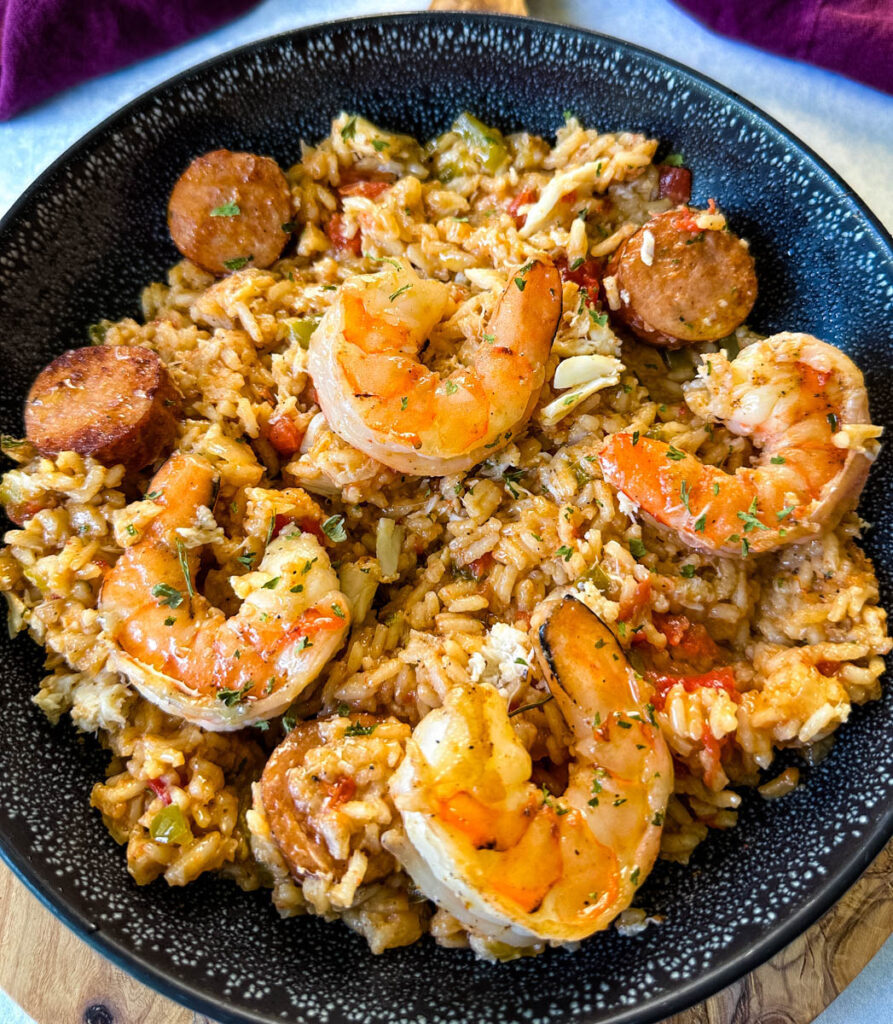
Frequently Asked Questions and Pro Tips
You'll want to use a pan or skillet that provides even heat distribution and allows you to easily sauté the vegetables and add the broth without overcrowding. Here are some options:
Cast Iron Skillet: Cast iron skillets are known for their excellent heat retention and even heating. They can create a beautiful caramelization on the apples due to their ability to hold and distribute heat effectively. I use a 12 inch for this recipe.
Stainless Steel Skillet: Stainless steel skillets also offer even heating and are durable. They are less nonstick than other options, so you might need to use a bit more oil or butter to prevent sticking.
Dutch Oven: Dutch ovens are known for their size and excellent heat retention and distribution.
Sauté Pan: A sauté pan has straight sides and a larger cooking surface, making it suitable for cooking large batches.
Yes, chicken even works great here. Slice skinless chicken breasts or thighs into chunks and cook it along with the sausage.
Leftovers can be stored tightly covered and sealed for 3-4 days.
For the stovetop method, add a little broth or water so the dish doesn't dry out. Reheat on medium-low heat until warm.
If using the microwave, cover the container with a microwave-safe lid. This helps trap moisture and prevent the rice from drying out. Reheat in short intervals.
You can freeze the dish tightly covered and sealed for 2-3 months. Defrost overnight in the fridge.
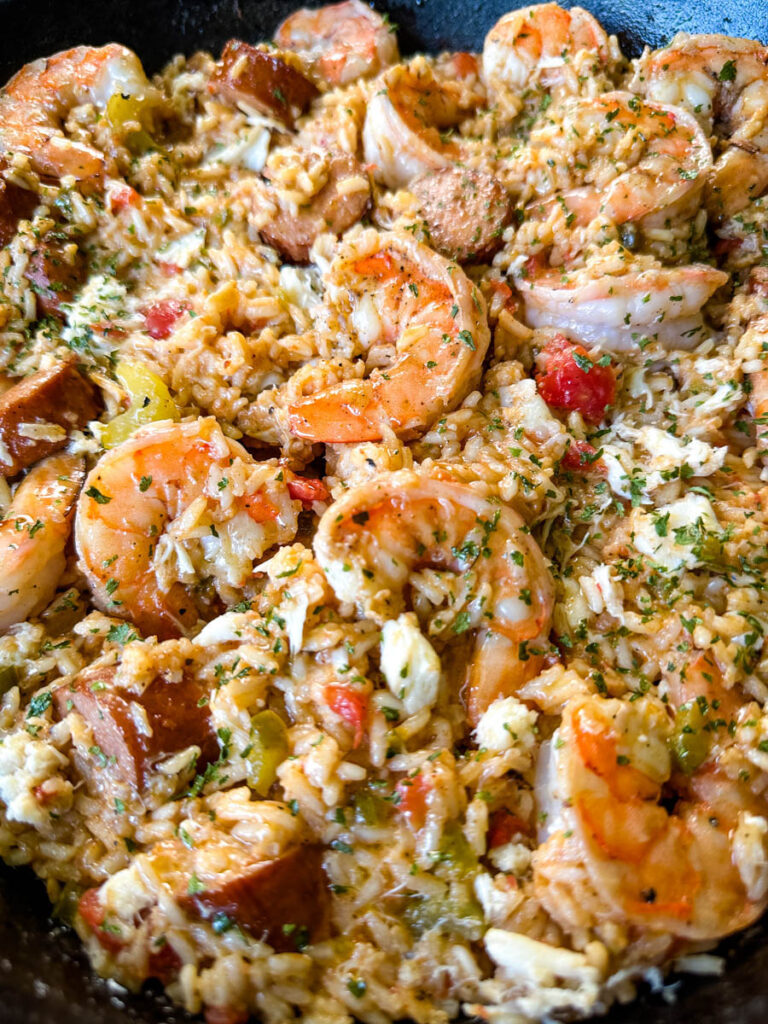
Pair Jambalaya With These Recipes
You can't go wrong with a nice chunk of Southern soul food cornbread, Southern coleslaw, air fryer garlic bread, and baked and roasted okra.
More Cajun and Creole Recipes
Cajun Crawfish Boil
Shrimp Etouffee Recipe
Cajun Dirty Rice
Southern Red Beans and Rice
Dirty Rice with Ground Beef
Cajun Fries
Cajun Chicken Wings
Cajun Shrimp Boil
Watch step by step instructions on how to make this recipe here on Youtube.



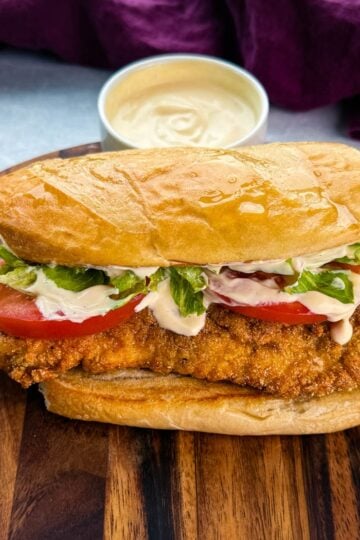
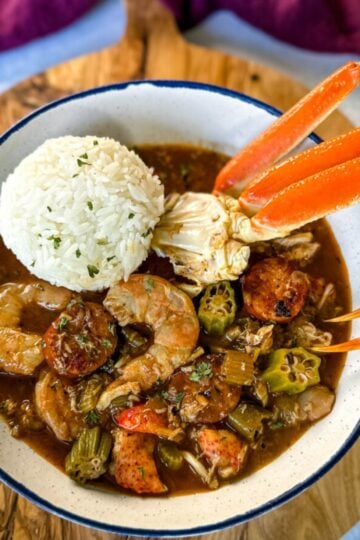
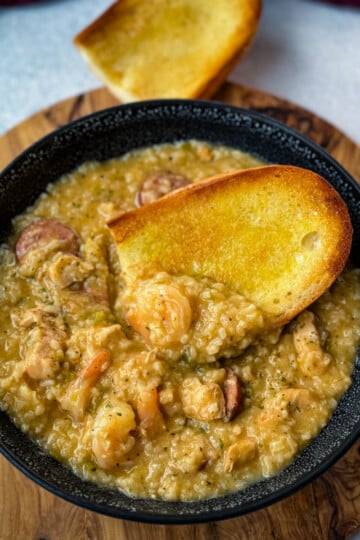
Ryan says
so good with the seasonings and all the vegetables
staysnatched says
The seasonings are what make it! Yes.